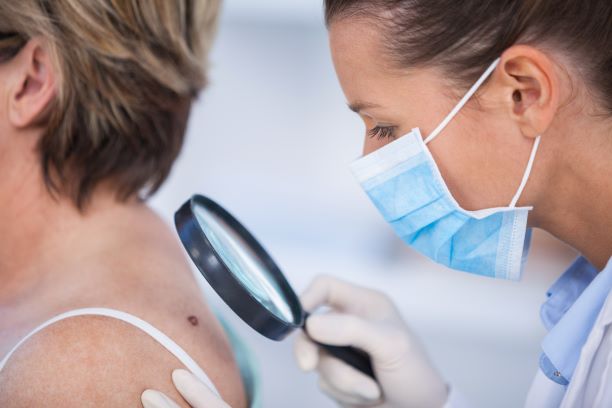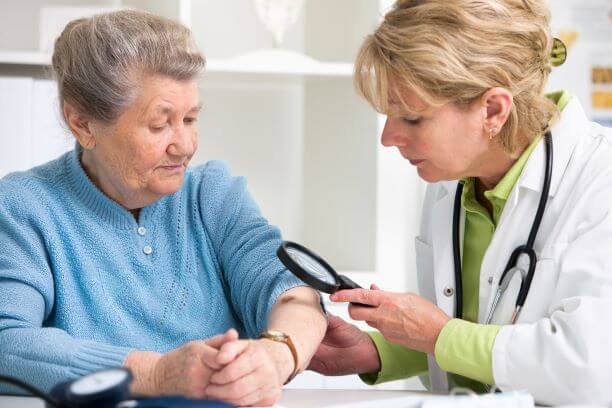Skin cancers are some of the most complex and serious conditions treated by dermatologists, and the U.S. Dermatology Partners team takes our role in preventing and treating all types of skin cancers very seriously. While some forms of skin cancer are not typically life-threatening, without proper treatment, there are serious health risks associated with all forms of skin cancer. According to Dr. Jessica Dorsey of U.S. Dermatology Partners in Cedar Park, Texas, “Most skin cancers are slow-growing and unlikely to spread to other parts of the body, but without treatment, just about any form of skin cancer has the potential to be destructive or even fatal.” Keep reading to learn more about the importance of regular screenings to catch skin cancer in the earliest stages and prevent the severe repercussions of untreated skin cancers.
What is Skin Cancer?
Skin cancer is a serious but common skin condition that causes skin cells to replicate in irregular ways or damages the structure of the cells themselves. While there are many different causes of skin cancer, exposure to the sun’s ultraviolet rays is the most common underlying cause of all forms of skin cancer. When damaged skin cells multiply, they form tumors. These growths can be either benign or malignant. Benign tumors are typically considered noncancerous or precancerous. Malignant tumors are more likely to impact surrounding cells or metastasize, which means they may spread to other parts of the body.
There are many different types of skin precancers and cancers. Skin precancers include actinic keratosis and dysplastic nevi (atypical moles). The four most common skin cancers are basal cell carcinomas, squamous cell carcinomas, melanoma skin cancers, and merkel cell skin cancers. Most skin cancers are either basal or squamous cell carcinomas. While melanomas and merkel cell skin cancers make up a small percentage of cases, they cause the greatest number of skin cancer-related deaths each year as these types are more likely to metastasize.
According to Dr. Dorsey, “The best way to prevent skin cancer-related deaths is to seek treatment in the earliest stages when these conditions are most easily addressed. There is a basic set of guidelines to help dermatologists and patients detect early signs of skin cancer. Early detection is KEY as this gives you the greatest chance for successful skin cancer treatment.”

A – asymmetry – the shape isn’t uniform throughout
B – border/bleeding – skin cancers often have irregular borders. Some can be round, but a lot of times their borders are irregular. Additionally, does the lesion bleed? Bleeding can be a sign of skin cancer.
C – color – is the lesion changing color? Does it have multiple colors within it? If so, you will want to have this spot evaluated by a Board Certified Dermatologist.
D – diameter – is the spot greater than the size of a pencil eraser? Is the diameter growing?
E – evolving – this one is potentially the most important. If you have a spot that is changing in its size or appearance – slowly or rapidly – it should get evaluated by a trained professional.
F – “funny looking” – This is the Ugly Duckling rule of atypical moles or skin cancer. If you have a spot that looks funny, or a spot that doesn’t look like all of your other spots, this is the “ugly duckling” rule. The spot that is unlike the others can be the most suspicious for malignancy.
What Happens if Precancers Go Untreated?
As the name suggests, precancers are damaged skin cells that aren’t considered cancerous, but if they are left untreated, these lesions are at high risk to become skin cancer. There are two main types of precancerous skin conditions: actinic keratosis and dysplastic nevi. Actinic keratosis looks like a rough, scaly patch of the skin that is usually red or brown. This condition may develop into squamous cell carcinoma if left untreated.
Nevi are moles, and dysplastic nevi is a term that means a mole is abnormal. Dysplastic nevi may develop into melanoma without proper treatment. While precancerous skin cancers are not malignant on their own, the potential to develop into life-threatening forms of this condition means they need to be evaluated regularly.
What Happens if Basal Cell Carcinoma is Left Untreated?
Basal cell carcinoma is the most common type of skin cancer, and it is considered very low risk for metastasizing and spreading to other parts of the body. It is typically very slow-progressing and is usually diagnosed and treated in very early stages. If left untreated, basal cell carcinomas can be locally destructive to the tissues where it grows, and it can invade deeper structures such as nerves, cartilage, and even bone. In most cases, basal cell carcinoma develops on the face, ears, neck, head, shoulders, hands, and other areas that receive frequent sun exposure. The tumors may look like raised bumps on the skin that are usually smooth and pearly/shiny in appearance. Blood vessels can sometimes be seen within the lesions, and in some cases, a wound (ulcer) may form and bleed easily.
What Happens if Squamous Cell Carcinoma is Left Untreated?
Like basal cell carcinoma, squamous cell carcinoma is relatively common, slow-growing, and at low risk to metastasize in most cases. This form of skin cancer is also likely to develop on the areas of the body that are exposed to sunlight like the face, hands, neck, shoulders, and lower legs, especially for people who have a history of sunburns. Unlike the smooth appearance of basal cell carcinoma lesions, squamous cell carcinoma tumors often appear as rough, thickened, scaly patches of skin. The growths may appear wart-like or like a donut shape. Squamous cell carcinoma lesions may form sores and bleed often or develop into a large, thick, and firm mass. Squamous cell carcinoma typically impacts people over the age of 50. While the condition does spread slowly, the risk that squamous cell carcinoma will spread to other parts of the body is higher than that of basal cell carcinoma. Additionally, these have the potential to arise suddenly and grow rapidly in some cases.
What Happens if Melanoma is Left Untreated?
Even though this form of skin cancer impacts a relatively low percentage of patients, melanoma skin cancers make up the majority of skin cancer deaths. Melanoma lesions often look like moles, freckles, or sunspots, and they may even develop within an existing mark on your body. Unlike other forms of skin cancer that are slow to progress and unlikely to spread to other areas, melanoma advances quickly and can form or spread anywhere on the body. In order to diagnose melanoma in the earliest stages, patients need to remember the ABCDEFs of melanoma, as discussed above.
What Happens if Merkel Cell Carcinoma is Left Untreated?
Merkel cell carcinoma is a rare but aggressive and potentially fatal form of skin cancer. It typically affects people above the age of 50 and those who have weakened immune systems. In most cases, Merkel cell carcinoma begins as a skin-toned growth that may bleed easily. The bumps or nodules may also have blue, purple, or red coloring. Because the Merkle cells are near nerve endings, this form of cancer has numerous health risks, and if left untreated, Merkle cell cancer may spread to the brain, lungs, or bones, becoming fatal.
Can You Prevent Skin Cancer?
According to Dr. Dorsey, “Skin cancer is an extremely serious condition, but with proactive care, most cases can be avoided altogether. In fact, taking a few small steps to limit sun damage and conducting regular skin self-exams is all you need to do to keep your skin healthy.” Because sun exposure is the main underlying cause of skin cancer, sun protection is essential to prevent this condition. Patients need to apply sunscreen every day and reapply at least every two hours during prolonged sun exposure. Whenever possible, limit or avoid time spent outdoors during peak sun hours between 10 am and 4 pm. If patients need to be outdoors during these times, it’s important to wear protective coverings, seek shade, and reapply sunscreen frequently.
In addition to daily sun protection steps, patients also need to perform self-exams at least every month. Early detection is key to providing effective skin cancer treatment, so regular self-exams are an essential part of keeping people healthy. Your Board Certified Dermatologist can walk you through a self-exam when you visit the office, but the basic process involves carefully examining your skin, from the top of your head to the bottoms of your feet (even in between the toes!), and noting any spots, lesions, bumps, discoloration, or other skin changes or irregularities. When you know where marks are on your skin, you’ll be more likely to notice if they are growing or changing in ways that are concerning or that indicate skin cancer.
Finally, you should visit a Board Certified Dermatologist once a year for a professional checkup and skin exam. During these visits, your dermatologist can talk to you about any spots that are concerning and help you improve or maintain your skin health. If you ever notice anything that concerns you during your at-home skin cancer exams, don’t wait for your annual visit to let your dermatologist know. Early detection is essential, so the sooner your dermatologist sees you the better.
Visit U.S. Dermatology Partners
If you’ve been diagnosed with skin cancer or are concerned about a lesion that may be cancerous, contact U.S. Dermatology Partners to schedule an appointment right away. You can complete our online scheduling request any time, and one of our team members will be in touch to finalize your appointment details. We care deeply about you and the health of your skin!
Find a location near me
or



